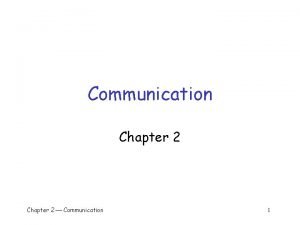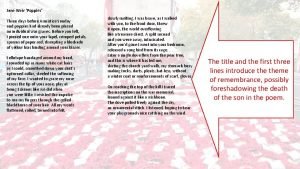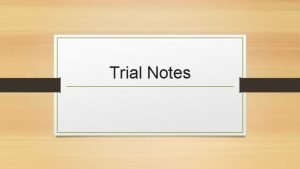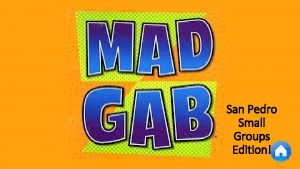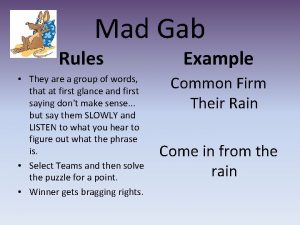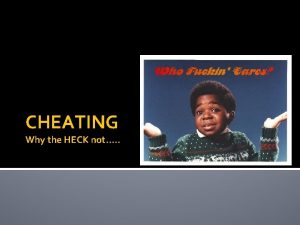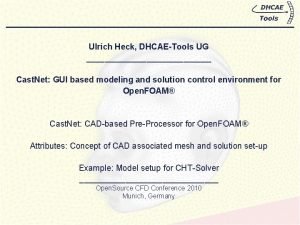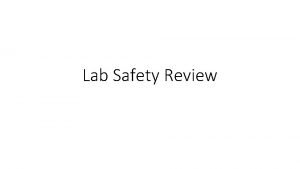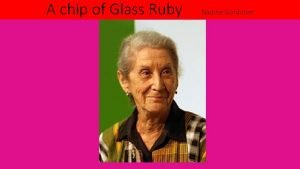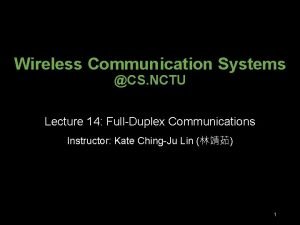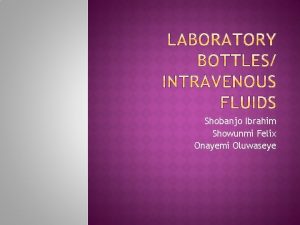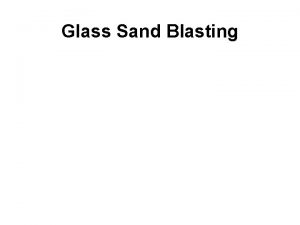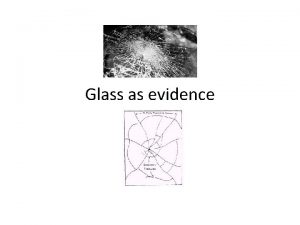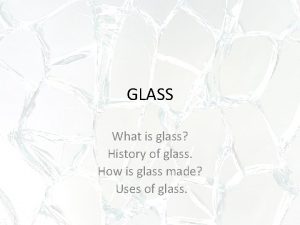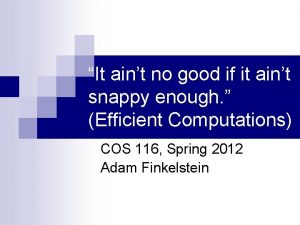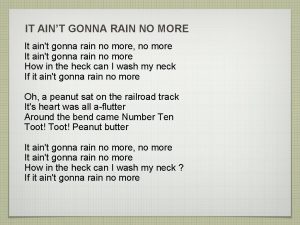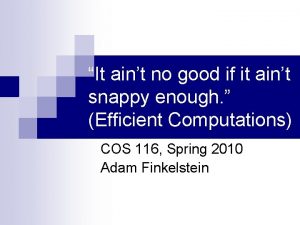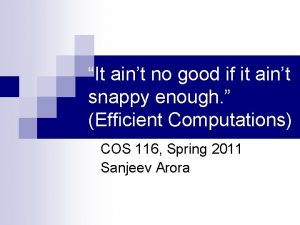The Glass Aint Half Full Heck its Overflowing






































- Slides: 38

“The Glass Ain’t Half Full, Heck it’s Overflowing!” The Power of a Strength-Based Approach in Reshaping the Lives of Troubled Children and Youth Charlie Appelstein, MSW www. charlieap@comcast. net www. charliea. com 1

Gus on Pejorative Labeling “Look, I know some of us can be quite difficult. I was a hellion my first six months, considered quite obnoxious. But it was simply defensive posturing. (Can you say defense mechanism? ) Kids aren’t bad. They’re just screwed up. The kid who’s pushing you away the most is probably the one who needs you the most. I think every residential center would be better off if they never used words as manipulative, lazy, un-invested, controlling, and obnoxious. They’re pejorative adjectives. When you label one of us in such a way, you contaminate the waters and no one wants to swim with us any more. “Manipulative kids aren’t fun to work with. ” “They’re a pain in the ass. ” “Boy , is that kid manipulative!” Every time we get blasted for being “manipulative” (or any other such term), our self-concept suffers. We take on that word – we internalize a sense of badness. Yet the kid you call “manipulative” might have come to your facility with a history of manipulating his way out of getting beaten. So, maybe manipulating ain’t so bad. Maybe it simply needs to be understood in the context of a child’s situation. Maybe people don’t need to use these words anymore. ” P. 24 “I had been an excellent math student, but the day she told me I was “spacey” and unfocused was the day I stopped connecting to math. ” Note: Throughout this handout will be references to the manuscript: Helping Traumatized 2 Children Learn produced by Massachusetts Advocates for Children www. massadvocates. org. The Gus Chronicles, Appelstein, 1994

Strength-Based Beliefs & Terminology Life isn’t what you see, it’s what you perceive! Pejorative Label Positive, Hope-Based Reframe Obnoxious Good at pushing people away Rude, arrogant Good at affecting people Resistant Cautious Lazy, un-invested Good at preventing further hurts, failures Manipulative Good at getting needs met Just looking for attention Good at caring about and loving yourself Close-mouthed Loyal to family or friends Different, odd Under-appreciated Stubborn & defiant Good at standing up for yourself Tantrum, fit, outburst Big message Learning disability Roadblocks Responding to Misbehavior: 3 Understand (behavior is always a message) > Reframe > Squeeze

Reframing involves taking a seemingly negative behavior and "reframing" it in a positive way. For example, a youth who appears hyperactive could be told: "Billy, you have a lot of energy. You can probably do more things in an hour than most of us can. I wish I could move like you. “ UNDERSTAND > REFRAME > SQUEEZE Try and reframe the following behaviors exhibited by troubled kids. Write down the reframe you might utilize: 1. A youth who is always looking for attention: 2. A youth who won't talk about his/her feelings: 3. A kid who acts rudely: 4. A child who makes funny noises at the wrong time: 5. A teenager who acts in a stubborn manner: 6. A child who tattles: 7. A youth who frequently swears: 8. A kid who's bossy with peers: 4

Providing Hope & Possibility Through Metaphors & Positive Predicting Poker The Melting Snowball “Life is like a poker game. Even if you’re dealt a bad hand, you can still win the game. ” The Roadblock “It’s not a learning disability; it’s a Roadblock. All big cities have them, but people get to work on time every day. ” “See your fears and worries about (pending issue/loss/transition) as a big snowball in the middle of your chest, and understand that as each day goes by, it’s going to melt a little. It may stay forever…but it will become so small that you can build a great life around it. ” The. Train The 2008 Edition Positive Predicting When you talk about the future in positive terms, you make any desired outcome more possible. And when it’s more possible, it becomes more probable! “You’re Big and Powerful…but a bit off track. ” “Cars and people improve every year. You’re the 2008 Ricky. You don’t overheat as much…have a sleeker design, follow 5 the road signs better…”

Strength-Based Practice What is it? : Emerging approach to helping people that is more positive and hopeinspiring. Powerful combination of the strength-building model and solution-focused therapy Emphasis is on: Strength-building rather than flaw-fixing Doing rather than understanding Believing in every youth unconditionally - See and believe!– Not “Believing is seeing” (positive responses are earned). . which produces Optimism – which feeds possibility, and motivates coping and adaptive behavior, even in the face of difficult odds: Hope is Mankind’s Fuel P. 57 “Lacking the words to communicate their pain, they may express feelings of vulnerability by becoming aggressive or feigning disinterest in academic success because they believe they cannot succeed. ” Begins with belief that all children have strengths and past successes that can be utilized to stop troublesome behavior. Continues with practice methods that identify and marshal these strengths for necessary behavior change. The Goal: Change rather than insight and awareness The Work: Problem-driven not problem-focused (solution-focused): Devoted to helping kids initiate actions to dispense presenting problems Primarily short term Goal-oriented and focused on resolving the identifying problem Assumptions (or lack thereof)…. Strength-based practice does not assume that ownership of guilt is somehow automatically curative. …Does assume that change is inevitable, not uncertain Strength-based practice does not assume LARGE problems require LARGE efforts 6 for solutions. …Does assume that SMALL changes can ripple out to bring resolution.

The Solution-Focused Approach A model of questions that help the student recognize and build upon inherent strengths…The Language of Hope and Possibility! Explorative Historical: How many kids have been, or are, in similar situations? How many succeeded? So why can’t you? What steps did they take to succeed? How will we celebrate when you get there? Qualifiers: “I hate this class!” > “So you’re saying you hate this class right now. ” Past Tense: “I’m stupid!” > “So you haven’t been feeling real smart lately. ” When & Will: “I’ll never make a friend!” > “When you do, what will it be like? ” Scaling Questions: “On a scale of one-to-ten, ten being that you’ll make lots of friends at the new school – zero, you won’t make any…. what number are you at now. When it’s higher in a month, how will you feel? Identifying In-Between Change “What will be the first sign that you’ve turned the corner. ” Changing Perspective Question: “How come you’re not doing worse? Exception questions: “Have there been times recently when the problem did not occur? ” Miracle Questions (considered by some the “hallmark” of solution-focused therapy) “What if you go to sleep tonight and a miracle happens and the problem(s) that brought you here are solved. But, because you are asleep, you don’t know the miracle happened. When you wake up tomorrow, what would you notice as you go about your day that tells you a miracle has happened and things are different? What else? Imagine your life 6 months from now, after we have worked together, and the problems you have now have been solved. What will be different? What else? ” Viewing the future without the problem enables students and families to see their current 7 difficulties as transitory, rather than everlasting. Visit: www. bobbertolino. com

Activities & Self Esteem Building (Doing vs. Understanding) To help kids with low self esteem, provide tasks and activities that offer a: Universal Opportunity for Individual Success P. 57 “Every child has an area of strength in which he or she excels, Whether it is in academics, art, music, or sports. When educators can identify and focus on a child’s strength, they afford the child the opportunity to experience success, with all the emotional implications of doing something well. This is an important starting point in mastering academic content and social relations, which in turn serve as a basis for success at school. ” Examples: • Modify or devise sporting endeavors that facilitate success, such as a softball game with no striking out • Academic tasks they understand can accomplish • Physical fitness pursuits (e. g. create a chart for walking/running) • Art work that is doable; music & dance • Special chores and/or work opportunities (e. g. helping in the office, cafeteria, with the maintenance staff) • Games, often of chance, they can all win • Helping or mentoring younger kids or those less fortunate • Community projects • Volunteering • Animal care Every kid needs his/her own special niche! Trumpet Success -Call home when a challenging student has a good day! -Have school personnel write congratulatory notes to a student who accomplishes a significant feat. -Post accomplishments on walls 8

Self-Esteem Building Options P. 57 “Every child has an area of strength in which he or she excels, Whether it is in academics, art, music, or sports. When educators can identify and focus on a child’s strength, they afford the child the opportunity to experience success, with all the emotional implications of doing something well. This is an important starting point in mastering academic content and social relations, which in turn serve as a basis for success at school. ” Games (board, video, bingo, etc. ) Ø World records, contests Ø Professional & amateur sports Ø Special events (food drives, car washes, bottle-collecting, walk-athons) Ø Karaoke & music (concerts, kazoo bands, shows, music videos, lip-syncing, etc. ) ØEmployment opportunities (Key: cultivate relationships with local employers) Ø Volunteering (w/handicapped, elderly, younger kids, animals, etc. ) Ø Sports (bowling, karate, roller-skating, soccer, etc. ) Ø Fitness (create fitness charts, aerobics, jogging/walking, meditation, rope and obstacle courses, etc. ) Ø Hobbies (art, theater, music, crafts, pottery, card and/or coin collecting, carpentry, photography, magic, etc. ) Ø Animals (pets, therapeutic horse-back riding, fish, etc. ) Ø Home repair jobs (painting, landscaping, repairing, etc. ) Ø Religious endeavors 9

Section Four: Helping Inflexible/Explosive Children & Youth Characteristics of Such Kids: • Display deficits in frustration tolerance • Generally do not respond well to consequences and rewards (i. e. traditional motivational approaches) • Symptoms are thought to emanate more from neurological as opposed to psychological factors • Prone to stubborn, inflexible, explosive outbursts • Often display genuine remorse after an episode How to Help: • Create user-friendly environments to clear the smoke (take the air out of the balloon) • Determine which behaviors need to be addressed and how best to respond. Categorize behaviors and responses into one of three baskets: A = Non-negotiable B = Compromise & Negotiation C = Ignore • As kids meltdown and approach vapor lock, immediately distract, empathize, and offer aid. Help them to downshift into a calmer state (i. e. make the cognitive shift). A B A = Non-negotiable, often a safety concern. Consequences could be issued. B = Room for compromise & negotiation C C = Ignore 10 Most of this material is from The Explosive Child by Ross Greene, Ph. D.

Strategic Verbal Interventions The Millimeter Acknowledgement “Do you think it’s slightly possible that perhaps, maybe…. ” “Could, maybe, 1% of this have something do with…” Honoring Hellos and Goodbyes “You can’t say hello until you have first said goodbye! Stages of grief: Shock & Denial, Anger, Sadness, Acceptance Examples: Goodbye to: Childhood Hello to: Adulthood Goodbye to: Teacher Assistant Hello to: New adult in their lives Tip: Replace cognitive distortion (stinkin’ thinkin’) Example: Angry that staff member is leaving, but feeling lucky that we got to work together for so long. 11

Cues to Use (Coping Thoughts/One-Line Raps) Encourage kids to create and practice coping thoughts - in the form of cues or one-line raps to diminish or eradicate problem behaviors (i. e. bad habits). Cues are more successful when they rhyme, are rhythmic, humorous and repeated often. Practice makes perfect! The brain is designed to change in response to patterned, repetitive stimulation. Anger Control NBD…easier than 1 -2 -3! NO BIG DEAL! Stop and think, don’t be a dink! Let it go, Joe (Just stay cool no need to blow) Let it go…So (So I can be happy or earn things, etc. ) When you’re mad…don’t do bad (or don’t get sad)…just talk or walk. Talk, walk, or squawk! Stay in control, that’s the goal. I can, I will, I gotta chill. Social Take turns when you talk, if you don’t the kids will walk. Give kids their space, it’s their place. Don’t poke, it’s not a joke. Stay arms lengths away…today. Following Through/ Being Independent Use Don’t quit, take it by bit Take it little by little and play da fiddle! Like a king on a thrown, I can do it on my own. Step after step, that’s the prep. Take it inch by inch…it’s a cinch! Sit and relax, learn to the max! Make a list, it will assist. Drugs and Alcohol I can make it if I choose, time to quit the drugs and booze. If you lose hope, don’t do dope. Bongos! View more cues at www. charliea. com Anxiety Don’t be in a hurry to worry. Stop and listen, cause you don’t know what you’re missing. Encouragement/Affirmations I’m smart. It’s in my heart. Learning is your (my) ticket to a good life. I can make it if I choose…Only I can make me lose. If it is to be, it’s up to me! 12

Practicing the Desired Behavior Stretch! Athletes always stretch their muscles before exercising or playing a game. For some students, a similar kind of preparation is necessary before engaging in an evocative activity. Children and youth who appear inflexible and are prone to explosive outbursts often have trouble functioning in physical activities that can be rough and unpredictable, such as touch football and basketball. Asking or requiring these students to “Stretch” prior to one of these activities, might prevent an injury or two! Example: 2 Minute Stretch Warm-up Form 1. 2. Is football a very physical and unpredictable game? Yes or No Is there a chance someone is going to hit, grab, pull, step-on, or trip me? Yes or No 3. If something rough happens to me, what do I think? a. “This is typical, don’t get mad. ” Yes or No b. “I’m upset. Let it go! NBD (No big deal!) Yes or No c. “If I make a bad choice and hit, I could hurt someone or get suspended. ” Yes or No d. “If I make a bad choice, people (can list names) will be unhappy with me. ” Yes or No e. “If I do well, they’ll be proud. ” Yes or No 4. Am I warmed up and ready to play? Yes or No . Suggestion: Create scripts to help students prepare for and practice potentially difficult interpersonal interactions. Example: “What can you say to yourself if you’re feeling bored? 13

The brain is designed to change in response to patterned, repetitive stimulation Stretch! Topic: ________ 1, Anger is a good emotion? YES NO 2. People like Martin Luther King used their anger to positively change the world? YES NO 3. Anger needs to be let out right? YES NO Take some deep breaths or count? YES NO Think about a pig in a mink coat? YES NO Say to myself “Stop and think, don’t be a dink, NBD, or Let it go, Joe? ” YES NO Take a step back and think – whom am I really mad at? YES NO Think about me being in a calm, beautiful place? YES NO 5. Sometimes we get too angry because of stinkin’ thinkin’ We overreact to situations, thinking the very worse? YES NO 4. When my anger starts to grow, it’s helpful to: 6. It’s often helpful to replace negative with positive, more YES hopeful thoughts? NO 7. If I get angry and make a lousy choice, there will be serious consequences…which stinks? YES NO 8. If I control my anger properly, like I’ve done many times in the past, we’ll all feel pretty good. YES NO 9. I’m an awesome person? YES NO 14 10. I’m going to make something of my life! YES NO

Externalizing Negative Behaviors Giving life and a name to a problematic issue or “bad habit” (i. e. externalizing it) can help kids with problematic tendencies/habits/compulsions. Examples: A student who needs to do things perfectly: “Get lost Mrs. Perfecto! Get out of here. Get off my back, you loser!” A student who is prone to behavior outbursts: “Get out of here Mr. Fitz!” A student who talks rudely: “Get lost Rudy! You’re nothing!” A student who argues incessantly: “Go far Mr. R!” “You’re through Mr. R Gue!” A student who is reluctant to write: “Get out of town, Mr. No Write!” Rudy A student who skips school or is frequently tardy: “Are you going to let I. B. Truant/Tardy get you into trouble next week? ” Create your own: ____________________15

Behavior Modification: Using an Incentive System • Reward Improvement. • Create an incentive system that’s easy to administer, and follow through! • Make incentive systems time-limited unless they are part of an ongoing plan. • If used for one or two kids, keep charts in a private place. Be discreet! • Award incentives in a private manner. • If other kids complain. “Why don’t I get checks and rewards? ” be honest with them, explain that every kid is unique and that some have special needs. Ask for their help in getting the child back on track. • Slowly raise expectations for incentives – but don’t act too fast. • In general, the more troubled a student appears, the greater the frequency he/she should be rated and rewarded. As kids improve, frequencies should decrease. • Be flexible! Incentive systems frequently need to be changed and modified. Kids often tire of the same rewards. A great deal of creativity and effort often needs to be put forth to successfully maintain systems. • Make incentive charts and/or document forms colorful (but age-appropriate) and easy to read. 16

Behavior Modification: Strategically Using Incentive Plans Tips: • Reward Improvement. • Create an incentive system that’s easy to administer, and follow through! • Make incentive systems time-limited unless they are part of an ongoing plan. • If other children/youth complain. “Why don’t I get to earn what he/she can? ” be honest with them, explain that every youth is unique and that some have special needs. Ask for their help in getting the child/youth back on track. • Slowly raise expectations for incentives – but don’t act too fast. • In general, the more troubled a youth appears, the greater the frequency he/she should be rated and rewarded. As behavior improves, frequencies should decrease. • Be flexible! Incentive systems frequently need to be changed and modified. 17

Suggested Rewards: Adults must provide rewards based on available resources (i. e. "best possible"). Ideally, the best pay-off for a kid is individual time with an adult. Allowing the youth to invite a friend is even more motivational. If circumstances and/or resources do not allow for kids to earn oneto-one time, than earning computer time or time doing something else that's enjoyable is preferred to paying-off with material items. Other non-material rewards include: • Special activity trips, additional free or recreational time, additional time at a favored activity, earning a special chore or activity, watching a video or having preferred music played. If material items need to be used as incentives, here are some options: • Comic books, pens and pencils, baseball cards, games, art supplies, puzzles, candy, gift certificates, money, food, cassettes, CDs, DVDs The Medium of Exchange • Younger kids often get excited about earning chips, tokens, “gold” coins, stickers, etc. , which they can trade-in for the items or privileges listed in the chart. These symbols of success are called the medium of exchange. For younger kids, having them earn (name) dollars is a fun approach to behavior modification. 18 Keyshawn Dollar

SB Principle: Little changes can ripple into big solutions Strategically use incentives to counteract cautiousness and unlock strengths Staying on Track, Jack! Name___________ Dates_______ Goal(s) for the week: M T W Th F Total Here’s some advice, talk real nice Mr. Fitz takes a hike Total_____ 8 checks = 30 minutes in the gym with a staff and friend. Key Principles: 1. Reward improvement 2. Assess and reward youth in correlation to the severity of their behaviors. 19

Jim’s Good Choices Plan No need to groan, I can start on my own. 2 M am * T T 3 Let it go, Joe. -- pm Here’s some advice, talk real nice. 3 1 3 W TH F Total for week______ Student can earn bonus points for practicing the one-line raps 3 = Great choices in this area 2= Okay choices 1= A few good choices -- = I’ll try harder tomorrow 20 Bonus, target behavior

Strength-Based Mission Statement We believe there is no such thing as a bad kid; just bad luck and bad choices. We believe that all of our students possess core strengths that can be utilized to help them make good choices and be effective learners. We strive to help students help themselves. Our approach involves mutually identifying, developing, encouraging, practicing, and maximizing the inherent strengths in every student we welcome through our doors. To accomplish our academic goals we establish a positive, upbeat, and safe environment that instills hope, provides multiple opportunities for success, and, at all times, adheres to the golden rule. We believe a good life is all about making good choices. Although we have deep respect and empathy for those students who have encountered difficult circumstances in their lives, our focus is on the present and the road ahead. 21

Understanding, Normalizing, and Learning from our Feelings Typical Feelings and/or Traps 1. 2. 3. 4. 5. 6. 7. 8. 9. 10. Angry Frustrated Out-of-Control Disgusted Guilty Sexual Insecure Afraid 9. Overwhelmed 10. Add your own Influenced by: Personal baggage, limited resources, quality and quantity of supervision & training, temperament, etc. Feelings: Acting on Them: Yes NO 22

The Observing Ego “I’m REALLY ticked…I could just it’s okay. Stay cool…ALL feelings are normal. Learn from this. I’m suffering a bad self-esteem injury, but in a little while it will heal. Respond instead of React. Use the Force, Betty! …I mean, Luke. ” Respond = The Golden Rule 23

Out of Control The Affect Scale Adult’s affect Child’s anger In Control Key: Establish inverse relationship As they get louder, you become more quiet 24

Loss of Control The Affect Scale Feeling Zone Child’s Anger Adult’s affect In control Inside the “feeling zone” there is room to model affect-laden content. Said in a controlled, but somewhat expressive manner: “John, I’m really upset about the choice you just made. ” “Mary, I’m angry about that. . . ” Key: If the child escalates through the zone, the adult’s affect should grow more muted. 25

Content vs. Message “You won’t be around next week? ” 2 weeks later… “You…won’t be around next week. ” Use “I” or “We” instead of “You” and start requests with “Please” and finish with “Thank you. ” ----------------------------------------- Body Messages “C’mon dude…let’s get it done, and then we can boogey. NBD brother. ” NBD = No Big Deal! vs. “You need to get it done now!” Speak to your students at eye level or below. Approach students in a calm manner. Be careful about your pace, posture, facial expression, hand movements and body position. 26

The Eco Map Rate Your Level of Support Finances Work Self Help Therapy, AA, Etc. School (adult) Recrea tion Neighbors Religion Schools (kids) Household Respons-ibilities Me Couple or Signif. Other Support Quotient _____ Other family Members Relatives Commu nity Orgs. Health & Medical (kids) Health & Medical (adult) Friends Strong source of support +3 The Support Continuum Serious drain & lack of support -3 27

28

Basic Verbal Interventions Supportive Interventions "You seem really upset!" Repeating or Paraphrasing w/qualifiers Youth: "I hate doing this. " Teacher: "You're saying you hate doing this right now. “ (Use qualifiers: yet, at the moment, right now, etc. ) Feelings Update "How do you feel about that? " Sandwich Approach "You made a bad decision to throw the paper, but I'm really pleased about how you walked away from the area. " Praise and Encouragement “Way to go!” “That was fantastico!” “I like the colors you selected” (praising the action versus the child) Humor To a fifteen-year-old: “You’re acting just like a teenager!” Apologizing "I'm sorry for raising my voice to you. ” Reasoning Responses "What if every teacher let her students. . " Connecting Statements "It's not me against you. I'm on your side. I don't like having to keep you back. " Empowering Interventions "What could you have done differently? " "What do you think we should do? ” Surface Clarifications "Let me make sure I know why you're upset. " Explorative Responses (psychological) "You don't usually get this upset. Could something else be bothering you? " Explorative Responses (historical) “Have you ever completed such a difficult assignment? “Have you ever got this angry and not hit someone? ” Explorative (reflective) “Is that behavior working for you? ” Plan Making "Can we make a plan to handle this situation better next time? " 29

Humor in the Lifespace Role of Humor Forms a bridge between adult/child world (i. e. counters resistance) De-mystifies individual persona/reduces power messages Enhances relationship building Tension reducer Provides effective modeling Improves self-esteem Enhances identity formation (e. g. niche theory) It's FUN!!! It's reflective of the environment Demonstrates caring Rules: Try! But give up quick Do not view the use of humor as an extra; it should be an integral communication technique. Make no assumptions about who can or can't be humorous - for everyone is capable! Avoid sarcasm Forms: Self-Deprecating Slapstick Joke Telling Grandiose Praise Humorous Games Musical Expression Poetry Transitional Objects & Humor Sustain "humorous" moments via: The written word Photos Recordings 30 Videos

Behavior Management: Understanding, Prevention, and Principles View misbehavior as a message: “Something is wrong. I need help. ” Try to respond instead of react to difficult behaviors. In other words, don’t say or do anything to a child or youth that you wouldn’t want said or done to yourself. Practice the Golden Rule Use your observing ego (e. g. “It’s an injury and it will heal. Respond instead of React”) Practice pattern identification. Note if a child or group act out in a predictable manner (i. e. at the same time each day, over the same issues, etc. ). Once a pattern is identified, investigate your (or the setting’s) role in contributing to the problem(s). What can you change, modify or practice? How can you make the environment more user-friendly? Next, seek out the studnets’s input and develop a plan. Constantly practice and reinforce the desired behaviors. Behavior experts suggest that students should hear four positive comments for every one negative. Use consequences instead of punishment. A consequence is related to an inappropriate behavior, a punishment is not. Consequences reinforce the values of your setting/society. In general, the sooner a consequence follows a misbehavior the more effective it will be. Try and avoid delayed consequences except for serious behaviors. Issue consequences that have a high probability of being accepted. Be careful about using traditional motivational approaches with non-motivational youth (A, B, C Baskets) Establish a limit setting progression. In other words, everyone should know exactly what happens if a student refuses to accept a limit. Use best possible interventions but advocate for resources to enhance the treatment climate. Whenever possible, and for more serious behaviors, try and let the youth or group decide the appropriate consequence(s). Practice progressive discipline 31

Limit Setting Limit setting progresses in five clearly defined stages: First: Second: Third: Fourth: Five: Supportive Logical Consequences Physical Intervention Processing Reintegration First Stage: Supportive Interventions include but are not limited to: Verbal prompts, reminders, warnings Redirection, distraction, divide & conquering Appropriate verbal dialogue (e. g. Compromise, negotiate, reframe, support and help, explore historically) Hydraulically squeeze (i. e. Find a benign place for the student (or group) to do the same behavior. Example: A teen who swears is allowed to swear one-on-one with an adult in a private location). Humor Non-verbal interventions (e. g. Hand signals, lights out, circulating around the room, etc. ) Use the power of a group Channel (e. g. Have an energetic kid do something physical) Hold an impromptu meeting Vicarious reinforcement (Praise another youth for the behavior you want the youth in question to display. ) In general, if two or three supportive interventions don’t work in a relatively 32 short time period, a logical consequence should follow.

Logical Consequences Proximity Manipulation Levels of supervision can be intensified when children and youth behave inappropriately: “John, would you please sit up front for the remainder of the class? ” “Carla, we're going to walk side-by-side to the gym. ” “Billy, you will need to be escorted from class to class until you’ve earned Back some trust. ” When a youth begins to improve his behavior, he can earn the incentive of gaining more freedom, with respect to his/her proximity to adults. Supervision levels can be created to address unsafe, problematic acting out, such as: In-sight, one-to-one, and close supervision. These levels – which represent proximity manipulation – can be adjusted as a kid or group regain (earn) their trust. Re-Doing Youth who have trouble meeting expectations, such as walking quietly to lunch, not running in the hallways, talking inappropriately, etc. , can be asked to re-do the specific task. “Okay John, I'd like you to go back to the door and try walking here again. . . sl-o-w-l-y. ” “Could you please try and redo this assignment? I don’t think it’s your best effort. ” “Could you please try and say that to me again? Thanks. ” Option: “I think you said I’m a wonderful dude and a sharp dresser, but I’m not sure. ” The Directed Chat When a student is not responding to supportive interventions, an adult – if conditions permit – can request a private chat, preferably in a different location. By changing location, it is often easier to approach the issue at hand with more calmness and emotional distance. Going to a neutral location often facilitates conflict resolution. An adult, for instance, could ask a disruptive youth to join her outside the 33 class for a minute. Oftentimes, by giving a student or group such attention, problematic behavior is ameliorated.

Removal of Attention At times, the best way to deal with negative behavior is to walk away from it and/or switch-off. Staff member: “You’re choosing to make me upset. I think I’m going to take a break from being with you now. I’m hoping that later we can work this out. ” If a staff member is becoming angry with a youth or group, a fellow staff member should be empowered to step in and take over for the person. Some schools/programs employ a “tag-off” like in professional wrestling. Natural Consequences Natural consequences involve discipline that it is a natural byproduct of one’s actions. Examples: “I think I am going to stop working with you now. I’m uncomfortable with your language. You could make better choices. I’ll check back with you in a little while to see if you can talk with me in a more civil manner. ” If a group is too loud and unruly an adult could just sit quietly and wait for them to calm down. Other consequences could be applied if this intervention isn’t successful. A youth refuses to do his homework. The natural consequence: He fails the test. A youth refuses to wear gloves. The natural consequence: Frozen fingers 34

Loss of Privileges Restricting a privilege, such as using a computer or going out to recess is generally a delayed consequence and should only be used for more serious behaviors or when minor behaviors become problematically repetitive. Bettelheim: Taking activities away from a troubled child is like taking cough syrup from a person with a sore throat Reparation (Restitution, Community Service, etc. ) If a child or youth acts out towards a human being or physical object, it invariably causes psychological and physical damage, respectively. It is, at times, helpful to have the youth (or group) that has offended repair the damage (within herself, as well). Examples: A youth is caught bullying others: Reparation: Have the youth apologize to the kids he/she has tormented and require her to help others for a certain duration of time. A student throws food in the kitchen: Reparation: Require the youth to help out in the cafeteria. Another way to frame this consequence is to view the act of repentance as “giving Back. ” Staff member: “Bill, you took away some of the respect and harmony we feel here by making the bad decision to damage the property. I’d like for you to give something back by coming up with a project that will contribute to the well-being of the school. You took something away…now give sonething back Whenever possible let the youth or group decide the consequence 35

Breaks (Time-Out) Children and youth often react negatively to the term time-out. As a result, it is best to use alternative terminology: “Could you please step outside the room and chill out? ” “Jim, I'd like you to sit on the bench, calm down, and think about making some better choices. ” “Sara, would you please walk to Mrs. Brown’s room for a short break, thanks. ” There are two forms of Breaks: Set Amounts and Open Ended Set Amounts = Established time-out lengths and progressions Example: 2 minutes > refusal > student must leave the room > refusal > administrator called & call home > processing. Open Ended = No set amounts of time for breaks Examples: “Could you please take a break in the back. ” > refusal > “The longer it takes you to move, the more likely I’ll have to keep you: (in at recess/after school, etc. )” 2 warnings (i. e. supportive interventions) > “Could you please take a break. Please return when you think you are ready to calmly join the group. ” 2 warnings (i. e. supportive interventions) > “Could you please take some space? I'll come and talk to you when you are sitting quietly. ” Where are Breaks Conducted? Best place: A non-stimulating area; a natural part of the room. You don't necessarily have to have specific time out areas. How are Breaks Conducted? Youth should always be allowed to sit comfortably to complete breaks. A break should be conducted in a quiet and respectful manner. The student does not have to be facing the corner or wall. “Time” counts when the child is sitting quietly. Do not start break time over if the youth begins to escalate. Give him/her credit for time already served. Do not have the youth stand to do a break. Don't keep adding time if the youth continues to misbehave: “Please let me know when you're ready to begin. ” 36

How Long Should Breaks Be? Considerations: The length of any time out varies according to a number of factors including • age of the child • behavior warranting the time out • safety concerns • whether the same or similar behavior has been previously addressed that day The older a child is, the longer the breaks can be. For elementary age children, the initial time-out could be anywhere from 1 to 5 minutes. For older kids, 5 to 10 minutes is appropriate. Experts talk about giving children one minute for each year they've been on this earth. (A sad price to pay for growing older. ) Break Tips: 1. Always say please and thank you when asking a youth to take a break. Monitor your tone (affect scale) and body language (the lower the better, no pointing, etc. ). Remember that a youth is most sensitive to the messages underlying your communications (content vs. message). 2. A set progression is often helpful when utilizing universal time out as a behavioral intervention. 37

Self-Management Options for Children & Youth Teach kids how to control their anger. Suggest the following techniques: 1. Stop and count to 5 or 10 (or 100!). 2. Take a deep breath. Breathe calmly. Take a step back from the scene. 3. Decide what the problem is? Suggest that a youth ask him/herself: “Who (or what) am I really mad at? ” 4. Think Cue! (NBD – easier than 1, 2, 3! - No Bi. G Deal, Walk or talk, Don’t be a fool – stay cool, Stand tall - make the right call, etc. ) 5. Think about alternative options (choices) – instead of acting inappropriately: Walk away (ignore) Ask for help Try and talk it out in a friendly manner Give a reason for the person to stop 6. Think about the consequences of making a good vs. a bad choice. “If I hit him, I’m grounded for a week. ” “If I walk away, I go to the Mall tonight and no hassles from home. ” “If I hit him, no soccer after school! “ 38 Have kids PRACTICE these self-management techniques – and reinforce + choices
 Aint no black in the union jack
Aint no black in the union jack Its overflowing
Its overflowing Half empty or half full
Half empty or half full Its halloween its halloween the moon is full and bright
Its halloween its halloween the moon is full and bright Your playground voice catching on the wind
Your playground voice catching on the wind Persistent and transient communication
Persistent and transient communication Poppies by jane weir
Poppies by jane weir How did heck tate behave on the witness stand
How did heck tate behave on the witness stand Bat tree snot ink looted mad gab
Bat tree snot ink looted mad gab Able owe knees hand which
Able owe knees hand which Why the heck not
Why the heck not Ulrich heck
Ulrich heck What the heck bro
What the heck bro Ulrich heck
Ulrich heck Heck tate is wise and tolerant
Heck tate is wise and tolerant Does hot glass look like cold glass
Does hot glass look like cold glass Glass ceiling vs glass escalator
Glass ceiling vs glass escalator If an acid is splashed on your skin, wash at once with
If an acid is splashed on your skin, wash at once with Which glass gets full first
Which glass gets full first A chip of glass ruby climax
A chip of glass ruby climax Types of direct retainer
Types of direct retainer Gerald croft
Gerald croft Rules of the game discussion questions
Rules of the game discussion questions Half woman half snake greek mythology
Half woman half snake greek mythology Softirq vs tasklet
Softirq vs tasklet Classification of retainers
Classification of retainers Minotaur greek mythology
Minotaur greek mythology Narnia half geit
Narnia half geit Hybrid mythological creatures
Hybrid mythological creatures Mulciber roman god
Mulciber roman god What is a half horse half man called
What is a half horse half man called Half vs full duplex
Half vs full duplex Ethernet full duplex vs half duplex
Ethernet full duplex vs half duplex Half wave rectifier meaning
Half wave rectifier meaning Setting of the story half a day
Setting of the story half a day Half duplex vs full duplex
Half duplex vs full duplex Geogg
Geogg Half strength darrow's
Half strength darrow's Full section vs half section
Full section vs half section





